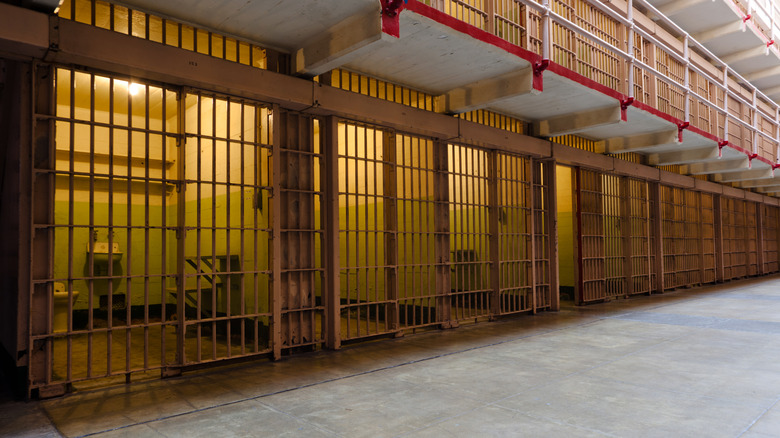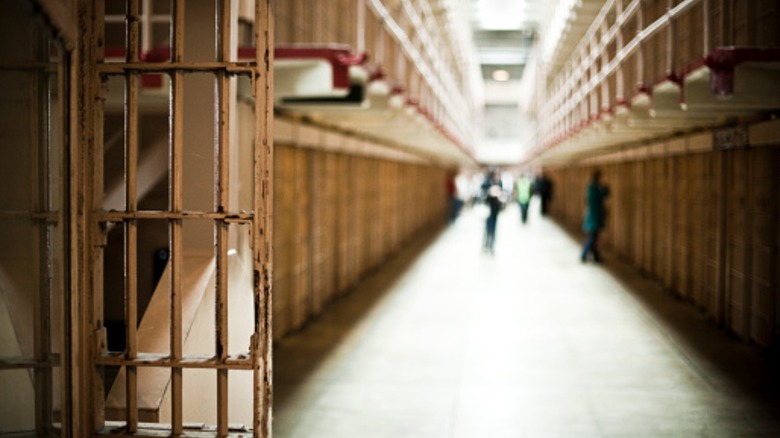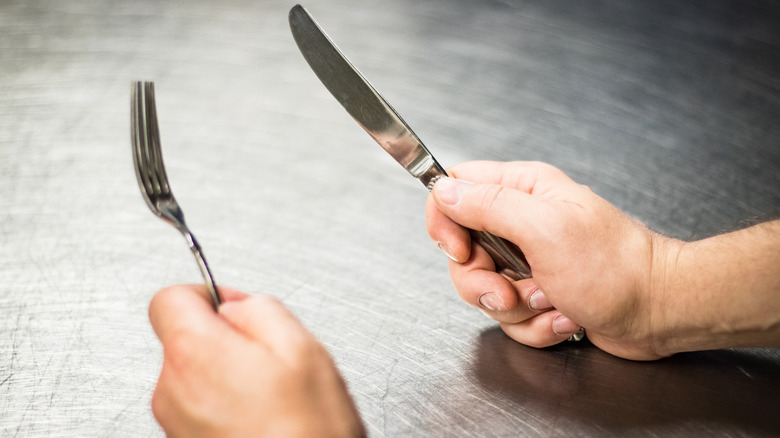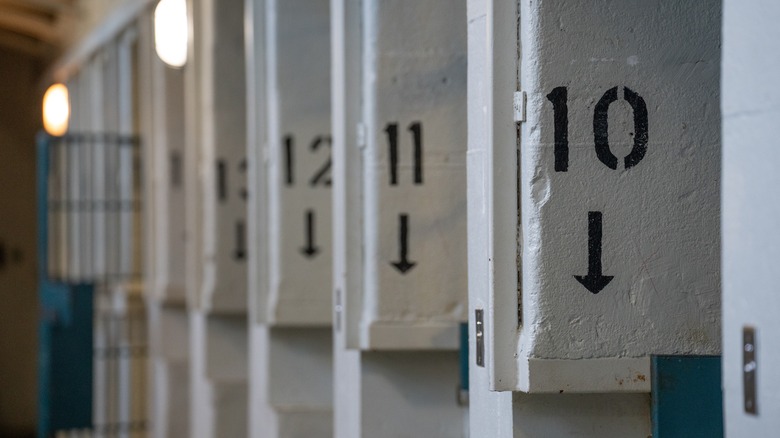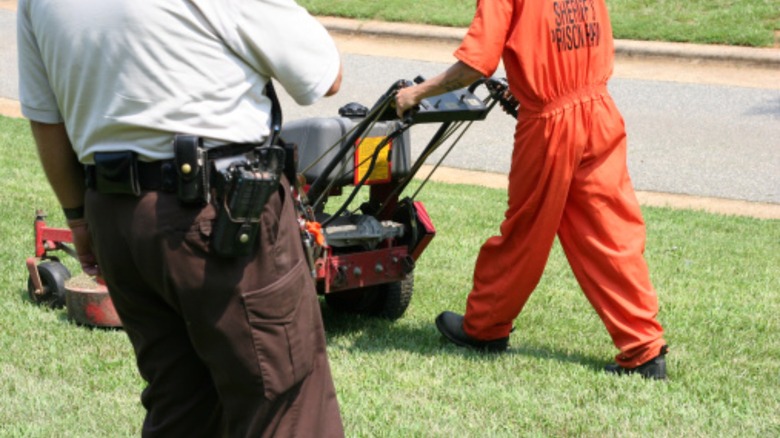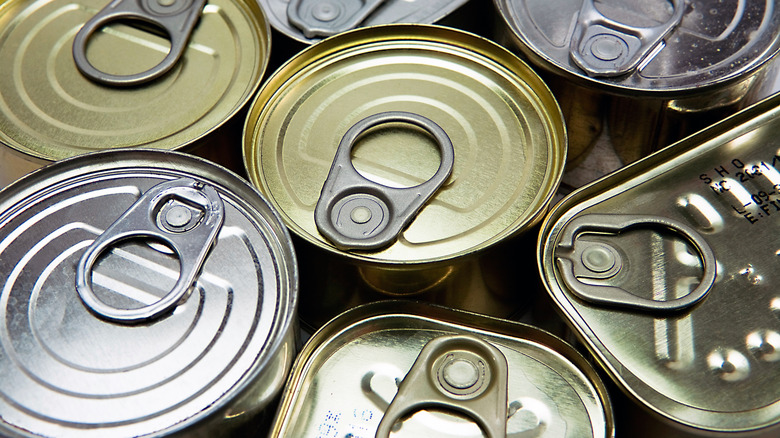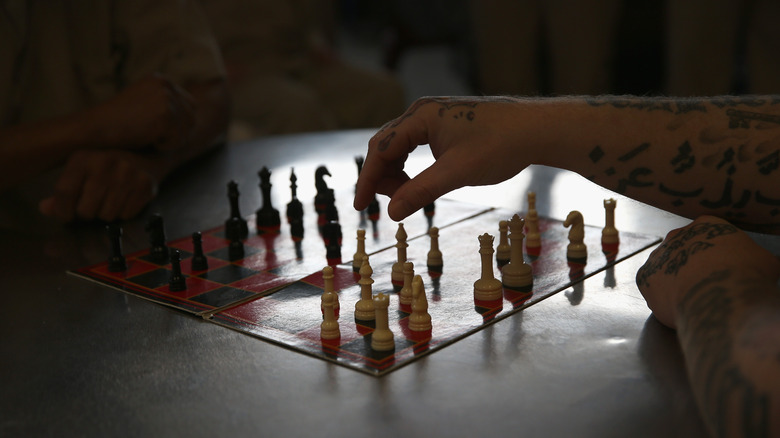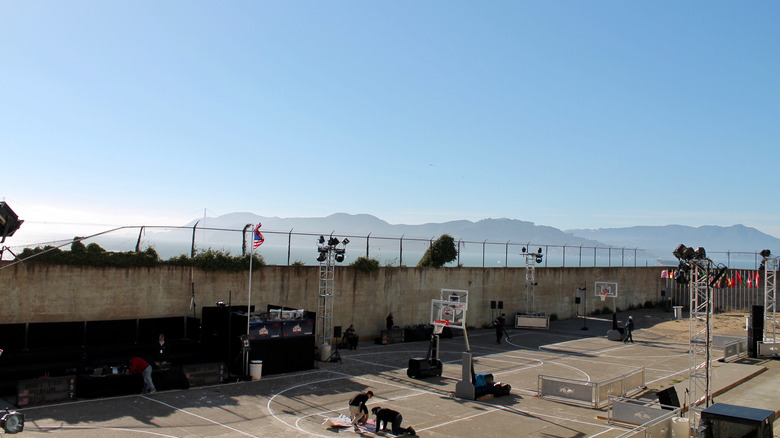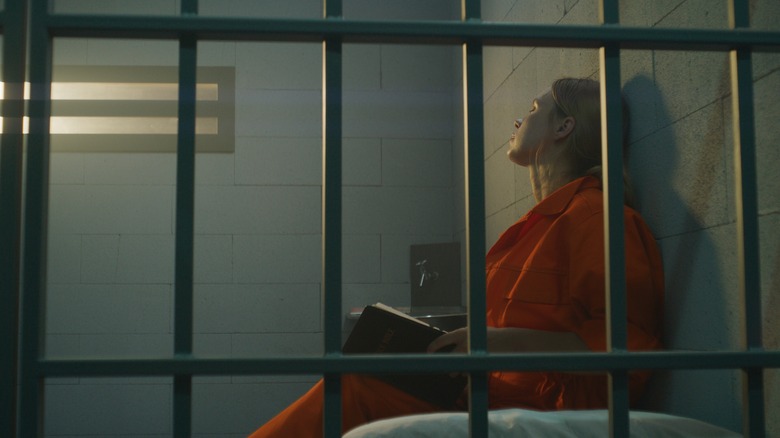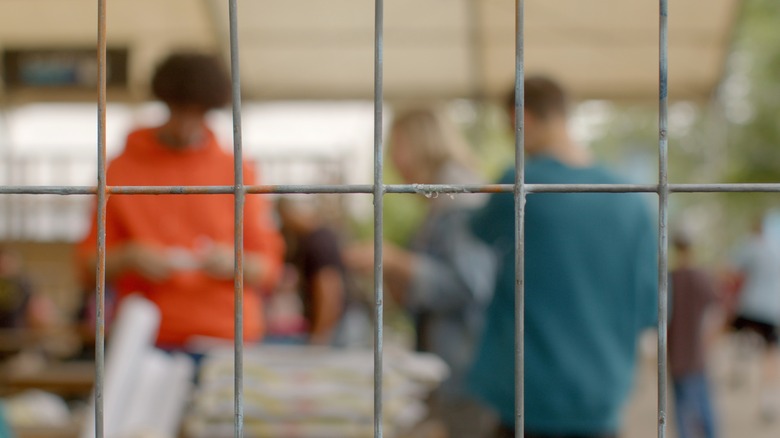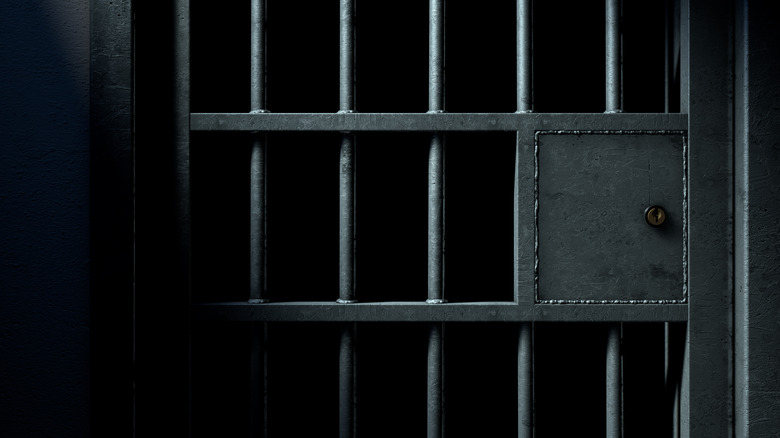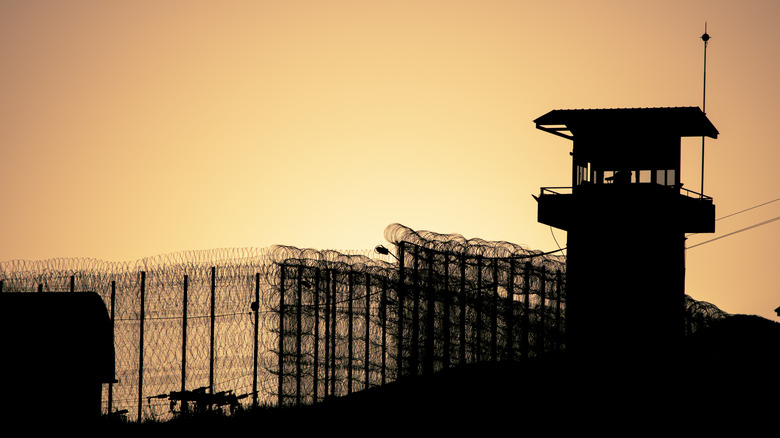What Prisoners Really Do In A Day
With over a million people behind bars at any one time, the United States, has the largest prison population in the world. And yet, while American prisoners still make up only a small proportion of the population, life inside prison is familiar to most of us, thanks to its representation in movies and on TV. From "The Shawshank Redemption" to "Orange is the New Black," audiences have been presented time and time again with versions of prison life, which are by turns inhumane and harrowing or else uncannily similar to life in everyday society. Similarly, with true crime attracting large audiences in recent years, news reports and tell-all documentaries give us a greater insight than ever before into the lives prisoners live behind bars. But are the impressions we have about prison life really correct?
Is a life of incarceration as torturous and scary as the media would have us believe, or instead deathly boring, a form of purgatory where the chief enemy is time? Since a surge of imprisonment in the 1990s, critics have argued that many prisons have become overpopulated and unsafe, leading to some prisoners living in appalling conditions. All prisons are different, and run by different rules, depending largely on their level of security, whether it be in low-security institutions, or the infamous supermax prisons, where the worst and most violent offenders serve their long sentences. Regardless, there are some common aspects to prison life, and so here is what life in a functional American prison is like, from dawn until after dark.
The prison day starts early
While prisons across America differ in countless significant ways, one commonality they all share is an early wake-up time for their inmates. Typically, from low-security to supermax prisons, prisoners are awoken in their cells by an alarm and security personnel at 6 a.m., though some institutions ring the alarm an hour earlier.
A prisoner's first responsibility at the start of the day is to get up and dress, and to make their bed before their cell is inspected. Prisoners typically wear regulation outfits, such as the common orange jumpsuit, or more downbeat workwear, although outfits vary from prison to prison.
Once cells are opened, prisoners can also use the bathroom. In many prisons, inmates are supplied with regulation "health and comfort items," or bathroom supplies, which they often have to look after themselves and ensure they last. In Florida, for example, prisoners are each supplied with one toilet roll and one bar of basic soap per week, though they are sometimes hit with supply shortages. Toothbrushes are also often regulation models, though new designs have seen toothbrushes made without regular handles, or of a special material that prisoners are unable to craft into a homemade weapon — a serious issue in prisons holding violent offenders.
Mealtime can be hectic
Breakfast takes place soon after prisoners wake up, at a very early hour, which depending on the prison may be between 6 a.m. and 7 a.m. For this first meal and all others, many prisons have a canteen where inmates eat together, often served by other inmates who work as chefs, porters, and dishwashers, a scene common in movies and on TV. However, writing for The Marshall Project, prisoner Jerry Metcalf paints a different scene.
According to Metcalf, his unit in Thumb Correctional Facility in Lapeer, Michigan, runs a self-service operation where prisoners heat up their own food in one of the unit's two microwaves. It sounds straightforward enough, but Metcalf notes that the machines have to be shared between a total of 96 prisoners in the unit, meaning that breakfast time is always a rush. Prisoners use the microwaves to heat up meals such as instant ramen and soup, but they're also used to make instant coffee, meaning a long line of hungry and caffeine-thirsty prisoners at peak times. To alleviate this, many prisons operate a shift system, with each wing or unit of the prison using the kitchen or canteen in turn to avoid delays and long waiting times.
Prisoners are counted regularly
One mandatory daily ritual behind bars is the count, the first of which occurs just as prisoners are waking up. In some units, there is another count just after breakfast, when they are required to return to their cells. As the name implies, the count is when prison security counts the collective inmates to ensure every prisoner is accounted for and their cells are in order. According to Jerry Metcalf, a typical call over the prison public address system will give breakfasting prisoners a five-minute warning before the count is due to take place, before adding: "Be on your bunks and be visible! I repeat, be on your bunks and be visible for 11:30 count or you will get a ticket!"
The length of time a count can take varies, depending on the unit, the number of inmates and staff, and any issues that may arise during the course of the inspection, and prisoners can find themselves waiting in their bunks for an interminable amount of time as the prison officers inspect each prisoner. However, in prisons such as Metcalf's, prisoners are allowed to perform tasks from their bunk while the count takes place, such as sending emails.
There may be other counts throughout the course of the day, depending on the needs of the unit in question. Some prisons will have a minimum of two counts a day, first thing in the morning and last thing at night, though others may have more, with extra counts in case of emergencies or security issues.
Work is available and usually voluntary
Like many adults living a free life outside of prison, a normal day for prisoners in most American prisons is dominated by work. And like the outside world, the work day typically begins in the morning just after breakfast, ceases for a lunch break, and continues throughout the afternoon to dinner time.
Prisoners can take on a wide range of jobs behind bars, some contributing to the prison's running. Some might find work in the kitchen or canteen, preparing and serving food for their fellow prisoners. Others will clean the halls of the prison and the bathrooms, or perform other useful functions, such as managing the laundry or landscaping on prison grounds. Others, however, will find work for private companies that use prison labor — which is extremely cheap — for tasks such as manufacturing.
For minimum security prisoners, work may take place outside the prison, with representatives from external employers coming to collect the workers in question. Contrary to popular belief, for in many states prison work is not mandatory, and the days of forced labor, such as that which took place on chain gangs, are in the distant past. Mostly, at least, since some states, such as Louisiana, still punish inmates who refuse to participate in work crews. Nonetheless, many prisoners find keeping busy passes the time, and earning even a meager income is better than nothing.
Shopping and bartering are both common activities
The earnings prisoners receive for their labor are notoriously small, so much so that some campaigners have argued that the pay is actually inhumane. The average prison wage in America can be measured in pennies, and in some states, such as Alabama, Arkansas, and Texas, prison wages doesn't exist at all. What little money prisoners earn can be spent at the prison store, or commissary. The commissary sells snacks and other desirable items, such as more luxurious toiletries than the prison provides.
But as well as the official funds that prisoners earn from whatever prison work they can get, many also use unofficial forms of currency, and bartering is ubiquitous. In the past, cartons of cigarettes were often used as currency, but since the Federal Bureau of Prisons banned smoking on site, the open presence of cartons of cigarettes has become prohibited.
Today, cans of fish — which are about the same size and shape as a carton of cigarettes – are sometimes used as bartering tokens among inmates, though any commissary items can be used. Some use such tokens to gamble, which is officially banned in prisons but which nevertheless occurs, or to trade for favors such as haircuts.
Incarceration often includes plenty of leisure time
As well as work duties, American prisoners are generally afforded a daily allotment of leisure time, which they can spend as they like. This is typically spent with solo activities like reading, writing, or painting, or in competitive games like chess and backgammon. Many prisons organize more communal activities, such as sports events, theater shows, and other performances by inmates or outside troupes.
It has long been understood by experts that recreation is an important cornerstone of prison life, and that it can have a significant impact on rehabilitating prisoners before they rejoin society. As such, many prisons require that the leisure activities prisoners choose for themselves have some tangible value in terms of personal growth. Indeed, it has been argued that adequate leisure time is protected by the Eighth Amendment, which prohibits cruel and unusual punishment.
However, the truth is that access to recreation and leisure time varies greatly from prison to prison and state to state. While a baseline exists in many prisons that mandates a minimum of five hours of leisure time a week, some prisoners report up to five periods of leisure, recreation, and relaxation a day, starting with exercise in the morning and movie night in the early evening. Even in federal supermax prisons leisure is encouraged, with libraries, movie nights, and quizzes organized for the dangerous prisoners' entertainment.
Exercise is a core part of prison life
An important part of any prison day is exercise time. Some prisons have a weight room, others have an open-air "yard" where gym and sports equipment are kept. Prisoners are free to lift weights, shoot hoops, or focus on other physical activities though demand for equipment is often high.
Exercise is vital for physical health, and becomes even more so among prisoners living in a state of confinement. Studies have shown that those who spend time in prison experience declining health, including weight gain and cardiovascular issues, both of which can be prevented by regular exercise. But more recently, health authorities have highlighted the importance of physical recreation for mental health and wellbeing, with exercise proven to lift mood and combat depression. Mental illness is a widespread issue among prisoners, meaning that regular exercise is a priority even among prisoners in high-security units. Prisons generally give inmates a minimum of an hour's exercise in the open air per day, though this can be increased or decreased based on a prisoner's behavior.
As such, certain prisons, generally those with lower security requirements, offer sports clubs and organize team events, which in some cases involve prison-run teams playing competitively against other prisons. Prisoners have testified that sports provide a release from prison life, and remind prisoners of the outside world, though historically there has been a debate over whether competitive sports offer a release of pent-up aggression among prisoners, or whether they exacerbate it. The same debate exists around the issue of weightlifting.
Daily religious ceremonies
Though imprisonment is primarily considered a form of punishment, an important function of the prison system is to allow inmates to grow as people, reflect on the issues that caused them to receive a prison sentence, and return to society as reformed and functional members of society. For many prisoners, such an experience of self-interrogation takes place within the framework of organized religion. Some prisoners return to a form of faith that they may have lost in the period shortly before their incarceration. Others find themselves turning to religion for the first time, their rights to do so while in prison protected by the First Amendment.
Religious texts are therefore familiar reading material for such prisoners. But faith behind bars is also nurtured in many prisons with daily religious services such as group readings of sacred texts, prayer meetings, gospel groups, and ceremonies such as Catholic Mass and Islamic Ta'Leem, catering to a wide variety of faiths. Often, professional chaplains work within the prison system as employees, though religious services may also be supported by volunteers, either from outside of prison or from among the prison population. Such figures are also on hand to counsel prisoners concerning issues with their personal lives, such as bereavement.
Prisoners are generally free to read religious texts whenever they have leisure time, while prayers may take place whenever a person's beliefs require it. In many prisons, religious services typically happen in the evening, shortly after dinner.
There are regular group meetings
Alongside religious services, the evening sees a whole range of specialist group meetings to help prisoners deal with various issues in their lives. Many of these groups are familiar to non-prisoners, and are found held in community centers across the country. Many prison groups focus on substance abuse and addiction, which can help prevent recidivism and increased drug use behind bars. Prisoners often have access to anger management courses and other forms of cognitive behavioral therapy (CBT). CBT is a popular form of therapy in the outside world, with a focus on supporting a person to change destructive habits of behavior, which is especially useful in supporting prisoners during the process of rehabilitation.
Prisoners with children may also take parenting classes, which teach them to be better guardians both behind bars and once they return to the outside world. For those concerned that they may relapse into a life of crime after their release, there are groups such as the 7th Step Foundation Club, which specializes in advising prisoners how to leave criminal behavior behind them.
Rehabilitation has long been a point of contention in the prison system, with activists having to fight for policies that support drug treatment behind bars. However, differences in laws in various states mean that such services are only partially available throughout the country, depending on where a prisoner is serving time.
Lights out
At around 8 p.m., prisoners who have been attending services, groups, or enjoying leisure activities are required to return to their dorm rooms and cell blocks, in time for a final count. Depending on the unit's rules, prisoners might have the chance to engage in quiet hobbies for an hour or two, either in a communal down area or in their cells. Many play chess or checkers, others take the opportunity to watch television and unwind. Later, prisoners may read in their bunks as they wait for the count to be completed and the cell doors to be locked.
The lights are usually turned off at 11 p.m. Night is often a tough time for prisoners, with many reporting that nighttime is the loneliest part of the day, and insomnia is a common issue in jail, which can in turn be detrimental to the mental health of prisoners. Some therefore wear earplugs and eye masks to block out light sources as well as the sound and movements of other inmates.
Night work
Prison officers are not the only ones still active after lights out in prison. While most prisoners are trying to sleep, others have to get up during the hours of darkness to fulfill various duties. Chefs and other canteen workers wake up especially early, being roused from their dormitories and cells as early as 3:30 am, ready to start work at 4 a.m. and prepare breakfast for the other inmates, though workers typically continue on their shifts to prepare meals for later in the day, too.
However, there are other more specialized and, it must be said, challenging jobs that prisoners are recruited to take on during the night. One of these is to attend to prisoners who are on suicide watch, which could mean being awoken by guards in the middle of the night, as Jerry Metcalf has experienced. He recalls in his Marshall Project article being taken to go and meet a depressed teenage inmate. As well as offering an open ear, his job is to ensure the prisoner doesn't come to any harm. After a three-hour shift, prisoners performing such duties return to their dormitories or cells and go back to sleep, to prepare for another day behind bars.
